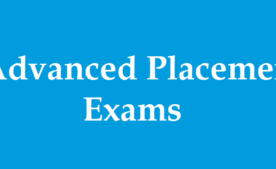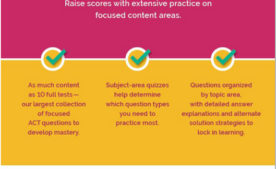If you’re preparing for an AP Calculus exam, chances are you’re already enrolled in an AP Calculus course. For those who are looking ahead, there are two different AP Calculus courses to consider: AP Calculus AB and AP Calculus BC.
Calculus AB is designed to be equivalent to first-semester college calculus, while BC is meant to represent a full year’s worth. Some high schools offer Calc AB for juniors and Calc BC for seniors; others give students the option to take one or the other. The BC course covers the same curriculum as the AB course, but BC adds further topics, including sequences and series, techniques of integration, parametric, polar, and vector-valued functions, and differential equations.
Most AP Calc test-takers select a test based on the class they’ve placed into. However, some students who find themselves excelling at their AB course work choose to self-study for the BC exam, knowing that BC scores supersede AB in the college applications.
In this blog, we will take a closer look at the Calculus AB and BC exams. We encourage you to purchase our 2-hour recorded AP workshops if you are interested in taking a deeper dive into these exams. In these workshops, one of our expert AP tutors gives a focused overview of the types of questions and the different strategies that students need to know to help them reach their full potential on these AP exams.
Know The Test Format
As with any standardized test, it’s important to be aware of the format in advance of test day. You should know, for example, that AP Calculus exams include sections for which calculator use is not allowed. There are two multiple choice sections—one without a calculator, and one with—and likewise, two sections of free response questions (FRQs), one with a calculator and one without.

Be sure to check that your graphing calculator is on the approved list (and that it has the built-in capabilities for AP Calculus)!
Know What’s Expected
In order to ensure you earn all the credit you deserve for your work, you’ll need to be aware of the rules and expectations of the exam.
Answers to all FRQs on the calculator section must be rounded to exactly three decimal places. Noting this instruction is critical for getting credit. Otherwise “correct” answers will not count if they are not rounded correctly. Be careful not to round prematurely, though—you don’t want to inadvertently reduce the accuracy of your answer before it’s final.
On the no-calculator FRQ section, you are not required to do any simplification. Any format that’s equivalent to the correct answer will receive full credit. For example, if the correct answer were ½, you could write “.5,” or “2/4,” or you could even write something like “(1+5)/(10+2)” if you wanted to. You can save time if you remember that you do not have to simplify your answers for this section.
Show your work. Showing your work for both free response sections is crucial: simply giving the correct answer is not sufficient for full credit. Of course, the test makers know that there may be many different approaches to a particular question, and scorers will have a list of possibilities to work with as they grade your test. You do not need to worry about selecting the “best” method. The scorers want to see that you have stayed on a legitimately correct path, so whichever method you choose, they will be looking for all of your steps and they will be assessing the correctness of your work. This means that you must even show the work that you put into your calculator! The graders need to see that you were able to come up with the right expression so they can affirm that you actually understand the steps.
Know the Best Practices
Avoiding unnecessary simplification is one way to maximize your time spent working on the test. Your experienced Summit tutor will be able to share other helpful strategies with you. Below are a few of our favorites.
Free response questions often have multiple parts that build upon one another. Don’t forget to complete the follow-up steps, but do take them one at a time—letting yourself get overwhelmed by what’s to come will only prevent you from earning points on the early stages! These multi-part questions often start easier and then increase in difficulty (though this is not a guarantee). Even if you don’t know how to do the last step, you can still get credit for the first few—and many students find that the previously intimidating last step looks much more approachable by the time they’ve worked through the others.
Some students find it frustrating that the multi-part FRQs build on one another. It’s important to know that you will not be double-penalized for wrong answers on these questions. Because you will be scored on your work, you can get part 1 wrong and still get full credit for parts 2, 3, and 4 as long as you have used correct methods and completed them accurately. In other words, if your answer to a previous step is incorrect but you use it correctly for a subsequent step, you will get full credit for the step that was correctly executed. Use this to your advantage: If you don’t know how to do the first part of an FRQ, just put down something that seems reasonable (and, ideally, is easy enough to work with). That way, you can proceed to step 2, where you may very well earn full credit even if step 1 was incorrect!
Know Your Stuff
Finally, it won’t come as a surprise to hear that you need to really know your calculus in order to succeed on either AP Calculus exam!
Use flashcards. Make sure you have all the common derivatives and integrals memorized, as well as formulas and rules [NH1] such as the product rule, the quotient rule, and the chain rule. You need to know these cold—trying to come up with the necessary rule or formula while also trying to solve a problem will just waste time. Be sure you have that information at your fingertips so you can use it fluently.
Make sure that you know how to both integrate and differentiate using your calculator, not just on paper (although that’s important, too!)
Practice FRQs throughout the year, consistently, whether or not your teacher is assigning them. You need to hone your skills in order to score well, which means you need to have seen these questions in advance. Winging it just won’t do. You can find practice FRQs to study from online.
Leverage available material. Although the official AP Calculus material provided by the College Board is limited, there are reputable sources for additional material. Khan Academy provides excellent AP Calculus modules, and it’s free! Look over the list of tested topics from the College Board. If any item on the list gives you that uncomfortable feeling that says it’s not a strong suit, work through the related Khan Academy module. And, of course, don’t be afraid to ask your teacher or your Summit tutor for further practice—they’ll be delighted to share additional resources. Taking and performing well in AP courses help students demonstrate their readiness for the rigors of college-level work. Many institutions report that a student’s successful AP experience favorably impacts admission decisions.
Whether you’re looking for ongoing AP subject support throughout the school year or the opportunity to review with an expert and prepare for the AP exam in May, we can help. Contact us about AP tutoring and exam prep. Would a 2-hour pre-recorded AP workshop better fit your schedule? Learn more.



















